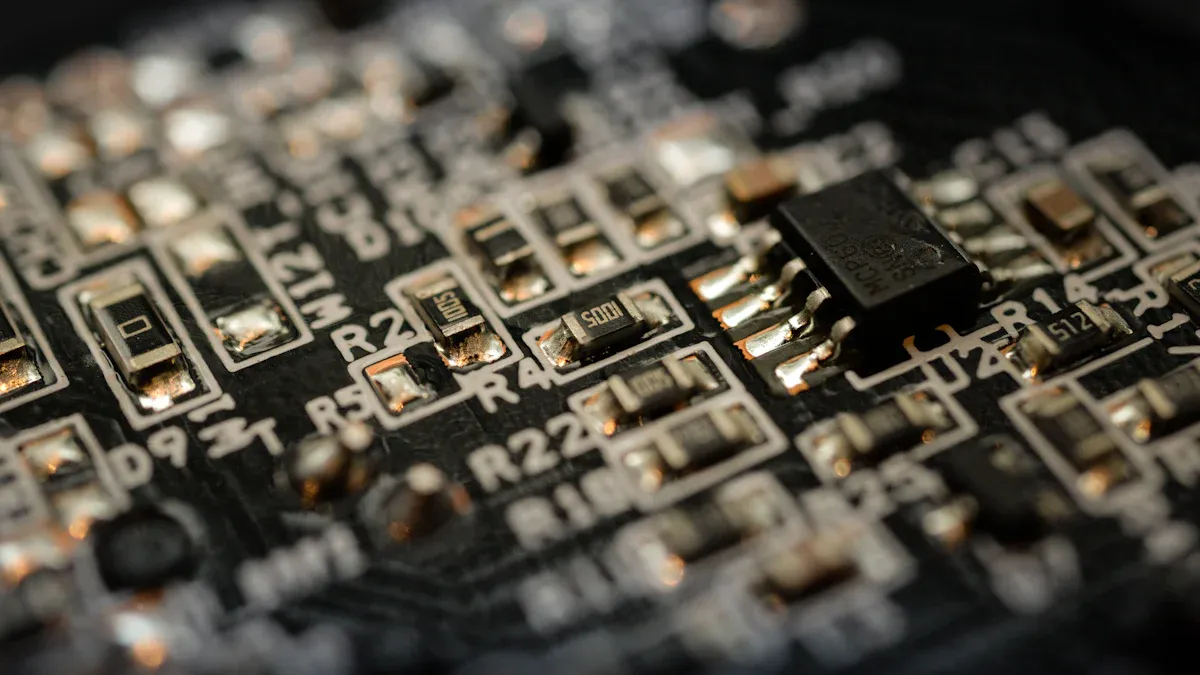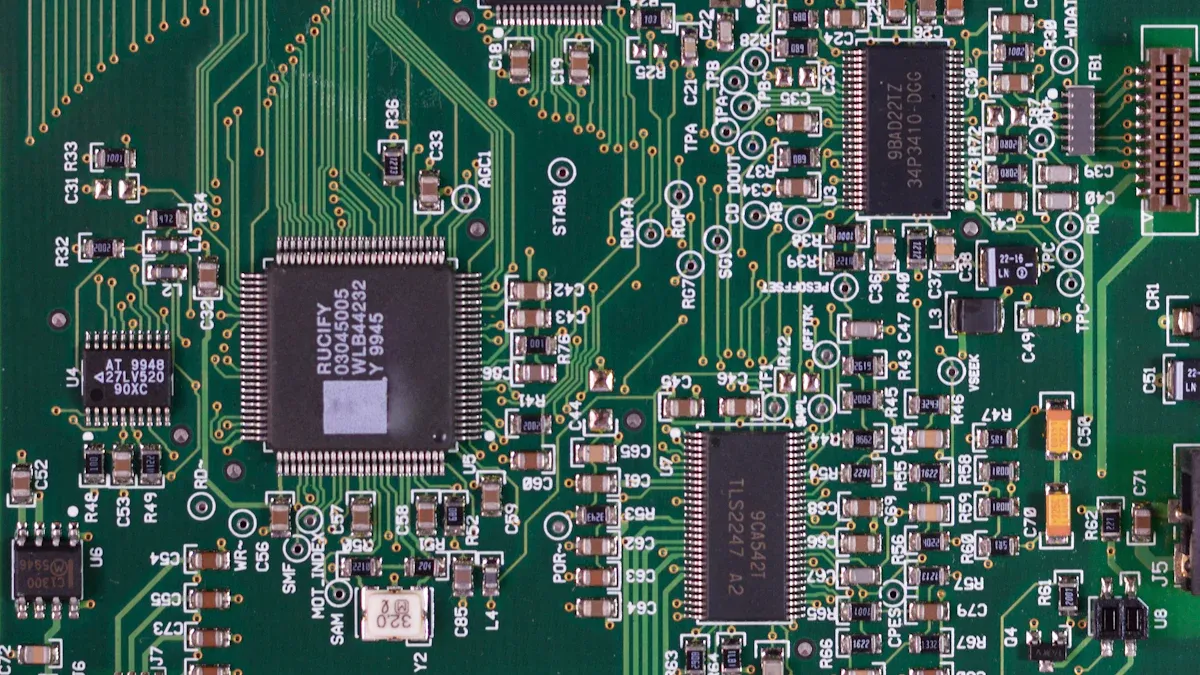How the C1815 Transistor Enhances Small Circuit Performance

The C1815 transistor helps small circuits work better. It has a high current gain of 70 to 700, which boosts signals well. This makes it great for audio preamps and RF circuits. It can handle up to 150mA of current, making it good for switching tasks like turning LEDs or relays on and off. Its low noise keeps signals clear, which is important for accurate circuits. From boosting weak sensor signals to steadying voltage in power supplies, the C1815 transistor is very useful and efficient.
Key Takeaways
The C1815 transistor improves small circuits by increasing current gain. It works well in audio and radio frequency (RF) projects.
Its small size and low price make it a favorite for both hobbyists and professionals working on electronics.
The transistor produces little noise, which helps keep signals clear. This improves sound quality in devices like microphones and amplifiers.
The C1815 can handle medium currents and voltages. This makes it useful for tasks like turning LEDs or motors on and off.
It works well in different conditions and uses power efficiently. This makes it a reliable choice for circuits that need to last a long time.
Understanding the C1815 Transistor

Key Specifications of the C1815
Voltage, current, and power ratings
The C1815 transistor is made for low-power uses. It works well in small circuits. It can handle up to 50V between collector and emitter. The collector-base voltage limit is 60V. It supports a collector current of 150mA, which is enough for LEDs or small motors. Its power dissipation limit is 400mW, so it runs efficiently without overheating. These features make it great for amplifying signals or switching tasks.
High gain and low noise characteristics
The C1815 has a high current gain (hFE) from 70 to 700. This helps it amplify signals effectively. Its low noise is perfect for audio circuits where clear sound is needed. It also has a high transition frequency of 80MHz. This makes it work well in high-frequency tasks like RF circuits.
Specification | Value |
|---|---|
Maximum Collector-Emitter Voltage | 50V |
Collector Current | 150mA |
Maximum Power Dissipation | 400mW |
Rated Frequency | 80MHz |
Features and Benefits of the C1815
Compact size and cost-effectiveness
The C1815 transistor is small, so it fits easily in tiny circuits. It is also affordable, making it a good choice for hobbyists and professionals. Its size and price make it popular for many electronic projects.
High efficiency and reliability
The C1815 uses little power but works consistently. Its strong design makes it reliable in different conditions. This makes it a trusted part for long-term use in small circuits.
Comparison with Similar Transistors
C1815 vs. A1015
The C1815 is an NPN transistor, while the A1015 is PNP. This difference affects how they work in circuits. The C1815 is better for high-frequency tasks because of its 80MHz frequency. The A1015 works better for low-frequency uses. The C1815 can also handle higher voltages, making it more flexible.
Advantages of the C1815 in small circuits
The C1815 is great for amplifying small signals because of its low noise and high gain. It handles moderate currents and voltages, so it works with many components. Its small size makes it perfect for compact circuit designs.
C1815 Circuit Example: Simple Audio Amplifier 🎵
Application: Small Signal Amplification
This circuit makes weak audio signals stronger. It can be used with microphones or small audio sources to drive speakers or other amplifiers.
Circuit Diagram & Components
🛠 Components Required:
C1815 Transistor (NPN)
Resistors:
R1 = 4.7kΩ (bias resistor)
R2 = 1kΩ (collector resistor)
R3 = 470Ω (emitter resistor)
Capacitors:
C1 = 10µF (coupling capacitor)
C2 = 100µF (bypass capacitor, optional)
Audio Input Source (e.g., Electret Microphone, AUX Signal)
Speaker (or Next Stage Audio Amplifier Input)
Power Supply: 5V – 9V
Circuit Diagram:
+VCC (5V/9V)
│
R2 (1kΩ)
│
C1815 (NPN)
│ │
C1 │ ├──► Output (to Speaker / Next Stage)
10µF │ │
│ │ │
│ R3 R1 (4.7kΩ)
│ (470Ω) │
│ │ │
GND ─────┴────┘
How It Works:
Small Signal Amplification:
The input signal (e.g., microphone) goes through C1 to the C1815 base. The transistor amplifies the signal using its gain (hFE: 70-700). The output signal at the collector is sent to a speaker or another amplifier.Biasing & Stabilization:
R1 and R2 set the base voltage for proper operation. R3 and C2 help keep the circuit stable and reduce noise.Output Signal:
The output is a stronger version of the input signal. It can power a small speaker or connect to another amplifier.
Applications of the C1815 Transistor
Signal Amplification
Audio preamplifiers and RF circuits
The C1815 transistor is great for making signals stronger. Its high gain and low noise help it work well in audio circuits. It boosts weak sounds, like from microphones, so they can be processed or heard clearly. The low noise keeps the sound clean without distortion. It also works in RF circuits, where it amplifies high-frequency signals for radios and communication devices.
Examples in microphones and radio receivers
In microphones, the C1815 makes tiny sound signals stronger. This helps them power speakers or recording devices. In radios, it boosts weak signals from the antenna. This ensures clear sound and stable reception. These uses show how the C1815 improves audio and RF systems.
Switching Applications
Controlling LEDs, relays, and small motors
The C1815 transistor acts as a switch in circuits. It can turn LEDs, relays, or motors on and off. It handles up to 150mA of current, which is enough for small loads. Its fast switching speed makes it reliable for digital circuits.
Examples in Arduino projects and electronic toys
In Arduino projects, the C1815 controls LEDs or relays for automation. For example, it can light an LED when a condition is met, like detecting heat. In toys, it powers motors or lights, adding movement or brightness.
Oscillators and Frequency Generators
Generating stable waveforms
The C1815 transistor helps create steady waveforms, like square or sine waves. These are used in tone generation, signal modulation, and timing circuits. Its high frequency (80MHz) ensures accurate and stable signals.
Examples in tone circuits and PWM generators
In tone circuits, the C1815 makes sounds for buzzers or alarms. It is also used in PWM generators to control motor speed or LED brightness. These examples show its ability to handle frequency-based tasks.
Practical Applications of the C1815 Transistor
The table below lists common uses of the C1815 in circuits:
Application Type | Description |
|---|---|
Amplifiers | Boosts audio, signal, and voltage levels with high gain. |
Switching Circuits | Works in digital circuits with fast switching and moderate power. |
Voltage Regulation | Keeps output voltages steady in power supplies. |
Oscillators | Creates stable signals for low-frequency tasks. |
Sensor Interface | Strengthens weak sensor signals for microcontroller use. |
LED Drivers | Adjusts current to control LED brightness. |
Sensor and Control Circuits
Boosting sensor signals
The C1815 transistor helps make weak sensor signals stronger. Sensors like LDRs or temperature sensors create tiny signals. These signals are too small to use directly. The C1815 boosts them to usable levels. Its high gain and low noise keep the signals clear. This makes it great for circuits needing accurate signal boosting.
Uses in LDR circuits and motion detectors
In LDR circuits, the C1815 increases small voltage changes from light levels. For example, in an automatic night lamp, it detects low light and turns on the lamp. In motion detectors, it amplifies signals from infrared sensors. This helps the circuit sense objects or movement well. These uses show how flexible the C1815 is for sensor circuits.
Voltage Regulation and Power Management
Keeping voltage steady in circuits
Keeping voltage stable is important for circuits to work well. The C1815 transistor helps by acting as a voltage regulator. It keeps the output voltage steady even if input voltage or load changes. This makes it perfect for small circuits needing stable performance.
Uses in battery checks and power circuits
In battery check circuits, the C1815 detects low battery levels and sends alerts. In power circuits, it keeps the output voltage steady to protect parts. For example, in portable devices, it ensures stable power for the circuit. This improves the device's reliability. These examples show how the C1815 helps manage power in circuits.
How the C1815 Improves Circuit Performance
Efficient Amplification and Switching
Uses little power
The C1815 transistor uses very little energy. This makes it perfect for battery-powered gadgets and small circuits. It stays cool even when used for a long time. This helps create small, energy-saving systems that still work well.
Keeps signals clear
The C1815 keeps signals clean and accurate. Its low noise ensures the output signal is not distorted. This is very important in audio circuits to keep sound quality high. By keeping the input signal clear, it improves how the circuit works.
Reliable for Small Circuits
Works well in tough conditions
The C1815 is strong and works in different conditions. It handles changes in temperature or load without problems. This makes it a good choice for circuits used for a long time.
Performs well in tight spaces
Small circuits need parts that work reliably in little space. The C1815 is small and works well in compact setups. It ensures stable performance, making it great for modern designs.
Useful in Many Applications
Fits many circuit types
The C1815 works in many circuits like amplifiers and switches. It handles both small power and medium current tasks. This makes it useful for many projects, saving time for engineers.
Easy to use with other parts
The C1815 is easy to add to circuits. Its pin layout works well with other components. It fits into audio amplifiers, LED drivers, and sensor circuits easily. This makes designs simpler and more efficient.
The C1815 transistor is efficient, flexible, and dependable for small circuits. Its low noise keeps audio signals clear and sharp. The steady hFE gain ensures it works well in different conditions. It can handle high voltage and current, making it useful for many tasks like amplifying or switching.
Feature | Description |
|---|---|
Low Noise | Keeps audio signals clean and clear. |
Steady hFE Gain | Ensures reliable performance in all conditions. |
High Voltage Handling | Handles high voltage safely in circuits. |
Current Control | Manages current flow for switching tasks. |
Flexible Uses | Works well in audio and switching projects. |
The C1815 improves circuit performance and is great for small designs. Both beginners and experts can use it to build creative and efficient projects.
What does the C1815 transistor do?
The C1815 transistor helps amplify signals and switch components. It makes weak signals stronger in audio and RF circuits. It also works as a switch to control LEDs, relays, and small motors in projects.
How does the C1815 help audio circuits?
The C1815 makes audio circuits better by boosting weak signals. It has high gain and low noise, keeping sound clear and clean. It is often used in microphones, preamps, and radios for improved sound quality.
Can the C1815 manage LEDs and motors?
Yes, the C1815 can handle LEDs and small motors. It works as a switch and supports up to 150mA of current. This makes it great for Arduino projects, toys, and automation tasks.
Why is the C1815 good for small circuits?
The C1815 is small, efficient, and affordable. Its tiny size fits tight spaces, and it uses little power. These features make it ideal for modern, compact circuit designs.
How does the C1815 keep voltage steady?
The C1815 keeps voltage stable by acting as a regulator. It provides a steady output even if the input changes. This makes it reliable for battery checks and power supply circuits.
CALL US DIRECTLY
(+86)755-82724686
RM2508,BlockA,JiaheHuaqiangBuilding,ShenNanMiddleRd,Futian District,Shenzhen,518031,CN
www.keepboomingtech.com sales@keepboomingtech.com
